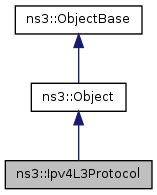Implement the Ipv4 layer. More...
#include <ipv4-l3-protocol.h>


Public Member Functions | |
| void | Insert (Ptr< Ipv4L4Protocol > protocol) |
| Ptr< Ipv4L4Protocol > | GetProtocol (int protocolNumber) |
| void | Remove (Ptr< Ipv4L4Protocol > protocol) |
| void | SetDefaultTtl (uint8_t ttl) |
| Ptr< Ipv4Interface > | FindInterfaceForDevice (Ptr< const NetDevice > device) |
| void | Receive (Ptr< NetDevice > device, Ptr< const Packet > p, uint16_t protocol, const Address &from, const Address &to, NetDevice::PacketType packetType) |
| void | Send (Ptr< Packet > packet, Ipv4Address source, Ipv4Address destination, uint8_t protocol) |
Static Public Member Functions | |
| static TypeId | GetTypeId (void) |
| This method returns the TypeId associated to ns3::Ipv4L3Protocol. | |
Protected Member Functions | |
| virtual void | DoDispose (void) |
Detailed Description
Implement the Ipv4 layer.
This is the actual implementation of IP. It contains APIs to send and receive packets at the IP layer, as well as APIs for IP routing.
Member Function Documentation
| virtual void ns3::Ipv4L3Protocol::DoDispose | ( | void | ) | [protected, virtual] |
This method is called by Object::Dispose or by the object's destructor, whichever comes first.
Subclasses are expected to implement their real destruction code in an overriden version of this method and chain up to their parent's implementation once they are done. i.e., for simplicity, the destructor of every subclass should be empty and its content should be moved to the associated DoDispose method.
Reimplemented from ns3::Object.
| Ptr<Ipv4Interface> ns3::Ipv4L3Protocol::FindInterfaceForDevice | ( | Ptr< const NetDevice > | device | ) |
- Parameters:
-
device the device to match
- Returns:
- the matching interface, zero if not found.
Try to find an Ipv4Interface whose NetDevice is equal to the input NetDevice.
| Ptr<Ipv4L4Protocol> ns3::Ipv4L3Protocol::GetProtocol | ( | int | protocolNumber | ) |
- Parameters:
-
protocolNumber number of protocol to lookup in this L4 Demux
- Returns:
- a matching L4 Protocol
This method is typically called by lower layers to forward packets up the stack to the right protocol. It is also called from NodeImpl::GetUdp for example.
| static TypeId ns3::Ipv4L3Protocol::GetTypeId | ( | void | ) | [static] |
This method returns the TypeId associated to ns3::Ipv4L3Protocol.
This object is accessible through the following paths with Config::Set and Config::Connect:
- /NodeList/[i]/$ns3Ipv4L3Protocol
Attributes defined for this type:
-
DefaultTtl: The TTL value set by default on all outgoing packets generated on this node.
- Set with class: ns3::UintegerValue
- Underlying type: uint8_t 0:255
- Initial value: 64
- Flags: construct write read
-
CalcChecksum: If true, we calculate the checksum of outgoing packets and verify the checksum of incoming packets.
- Set with class: BooleanValue
- Underlying type: bool
- Initial value: false
- Flags: construct write read
-
InterfaceList: The set of Ipv4 interfaces associated to this Ipv4 stack.
- Set with class: ns3::ObjectVectorValue
- Underlying type: ns3::Ptr< ns3::Ipv4Interface >
- Flags: read
TraceSources defined for this type:
- Tx: Send ipv4 packet to outgoing interface.
- Rx: Receive ipv4 packet from incoming interface.
- Drop: Drop ipv4 packet
Reimplemented from ns3::Object.
| void ns3::Ipv4L3Protocol::Insert | ( | Ptr< Ipv4L4Protocol > | protocol | ) |
- Parameters:
-
protocol a template for the protocol to add to this L4 Demux.
- Returns:
- the L4Protocol effectively added.
Invoke Copy on the input template to get a copy of the input protocol which can be used on the Node on which this L4 Demux is running. The new L4Protocol is registered internally as a working L4 Protocol and returned from this method. The caller does not get ownership of the returned pointer.
| void ns3::Ipv4L3Protocol::Receive | ( | Ptr< NetDevice > | device, | |
| Ptr< const Packet > | p, | |||
| uint16_t | protocol, | |||
| const Address & | from, | |||
| const Address & | to, | |||
| NetDevice::PacketType | packetType | |||
| ) |
Lower layer calls this method after calling L3Demux::Lookup The ARP subclass needs to know from which NetDevice this packet is coming to:
- implement a per-NetDevice ARP cache
- send back arp replies on the right device
| void ns3::Ipv4L3Protocol::Remove | ( | Ptr< Ipv4L4Protocol > | protocol | ) |
- Parameters:
-
protocol protocol to remove from this demux.
The input value to this method should be the value returned from the Ipv4L4Protocol::Insert method.
| void ns3::Ipv4L3Protocol::Send | ( | Ptr< Packet > | packet, | |
| Ipv4Address | source, | |||
| Ipv4Address | destination, | |||
| uint8_t | protocol | |||
| ) |
- Parameters:
-
packet packet to send source source address of packet destination address of packet protocol number of packet
Higher-level layers call this method to send a packet down the stack to the MAC and PHY layers.
| void ns3::Ipv4L3Protocol::SetDefaultTtl | ( | uint8_t | ttl | ) |
- Parameters:
-
ttl default ttl to use
When we need to send an ipv4 packet, we use this default ttl value.
The documentation for this class was generated from the following files:
- src/internet-stack/ipv4-l3-protocol.h
- doc/introspected-doxygen.h
 1.7.1
1.7.1